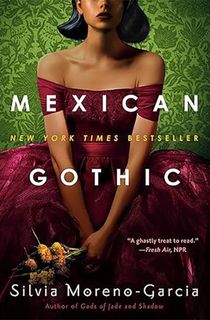Silvia Moreno-Garcia debuted in 2016 with Signal to Noise.
While the Mexican-Canadian novelist has written several books since then, she is perhaps best known for her bestselling Mexican Gothic, which won an Aurora, Locus, and British Fantasy Award, and was shortlisted for a Bram Stoker and Shirley Jackson Award.
Not only is Mexican Gothic a thrilling entry into Moreno-Garcia’s body of work, it also showcases her ability to write gothic horror, earning apt comparisons to Shirley Jackson’s The Haunting of Hill House as well as the works of Mexican filmmaker Guillermo del Toro.
What Is The Main Plot Of Mexican Gothic?
Set in 1950s Mexico, Mexican Gothic follows socialite Noemí Taboada after receiving a curious yet chilling letter from cousin Catalina claiming someone is poisoning her and begging to be saved from doom and downfall.
With a sudden urgency, Noemí journeys to the equally curious yet chilling High Place, a distant house in the Mexican countryside; she is intent on ensuring her cousin is safe and sound after marrying a handsome yet mysterious stranger.

Mexican Gothic
What Characters Are We Dealing With?
Who is his handsome stranger? Why is the Doyle family so secluded? What secrets are hidden, and buried, at High Place? Most importantly, is Catalina safe? Noemí is determined to find answers, and to get a chance to talk to her cousin, only to face obstacles at every turn. It is here that Moreno-Garcia’s characters come to life—in more ways than one.
There is Virgil Doyle, Catalina’s husband, who appears to be at turns cold and charming, distant and devious. Meanwhile, his reserved aunt Florence Doyle, the mistress of High Place, insists on silence—and most importantly, secrecy—at all times. The walls have both ears and eyes, as Florence seems to hear any conversation that takes place within them.
Moreno-Garcia also takes care in developing well-rounded side characters, including overbearing Patriarch Howard Doyle, who is preoccupied with thoughts of eugenics, before taking an unwelcome interest in Noemí. Lastly, there is shy and nervous Francis Doyle, who might be Noemí’s only chance at having a friend at High Place; but who is afraid of revealing the secrets hidden behind the walls.
Is The House Alive Too?
What was intended to be a short visit, turns out to be a lengthy one, as Noemí is only allowed to see Catalina with supervision. Also, Catalina still doesn’t seem like herself.
She’s been having unsettling dreams and hearing voices in the walls; soon Noemí begins having them, too, as well as visits from ghosts who may or may not be real. Everything at High Place feels, looks, and sounds off—even the lingering silence.
Is the house magical, cursed, or both? In Moreno-Garcia’s telling, the house is a character as much as the people themselves. As the story continues, Noemí develops an even stronger conviction to rescue her cousin from an enigmatic husband and an eerie house, hoping to return to Mexico City with Catalina by her side.
There is just one problem—That is, once you visit High Place, it is nearly impossible to leave. That’s not the only barrier. Florence, ever-so-suspicious of outsiders, is wary of Noemí’s intentions, especially the unapproved decision to bring an outside doctor to examine Catalina. Florence and Howard are determined to ensure that Noemí stays at High Place—forever.
Mexican Gothic's Underlying Themes Of Colonialism
Upon learning just some of the haunting secrets of High Place, including violence and greed, Noemí takes matters into her own hands.
In telling this story, Moreno-Garcia is not only narrating a story of gothic horror. She is also touching upon colonialism, in relaying the story of Doyles, whose empire fell from grace after a long history of worker exploitation.
In this case, Howard Doyle represents colonizing parties who profited from the theft of Indigenous resources, treated workers as disposable, and left areas destitute once work ended.
The theme of colonialism is also on display as Howard Doyle longs for immortality, while living in a crumbling mansion in a collapsing town; unaware of how many workers died under his watch.
Mexican Gothic's Underlying Themes Of Feminism, Female Empowerment, And Female Resistance
Other themes include feminism and female empowerment
As a socialite, Noemí is expected to devote her time to finding a husband. However, her interest in education, especially anthropology, at a time when few women were allowed to pursue higher education, shows her resolve.
Noemí seeks to work around outdated gender roles as she sets out to protect not only herself, but also Catalina from the sexism, and patriarchal order, within High Place.
This is also a story of female resistance, as Noemí and Catalina both push back against roles that were imposed upon them, taking a chance at gaining freedom while also freeing other women trapped at High Place.
All of these themes intertwine to focus on life and rebirth, a theme present in several of Moreno-Garcia’s novels. In the end, Noemí, Catalina, and even Francis find themselves anew, and readers may too, long after they’ve finished the last page.
Book Recommendations If You Liked Mexican Gothic
If you enjoy this book, here are some others like it, spanning the 1970s to the present day.
- If you like the historical setting of Mexican Gothic combined with gothic suspense, try The Hacienda by Isabel Cañas.
- If you’re looking for another woman-led story about navigating intergenerational trauma, pick up The Haunting of Alejandra by V. Castro.
- If you’d like an action-packed story about choosing your own destiny, check out Tender Is the Flesh by Agustina Bazterrica.

